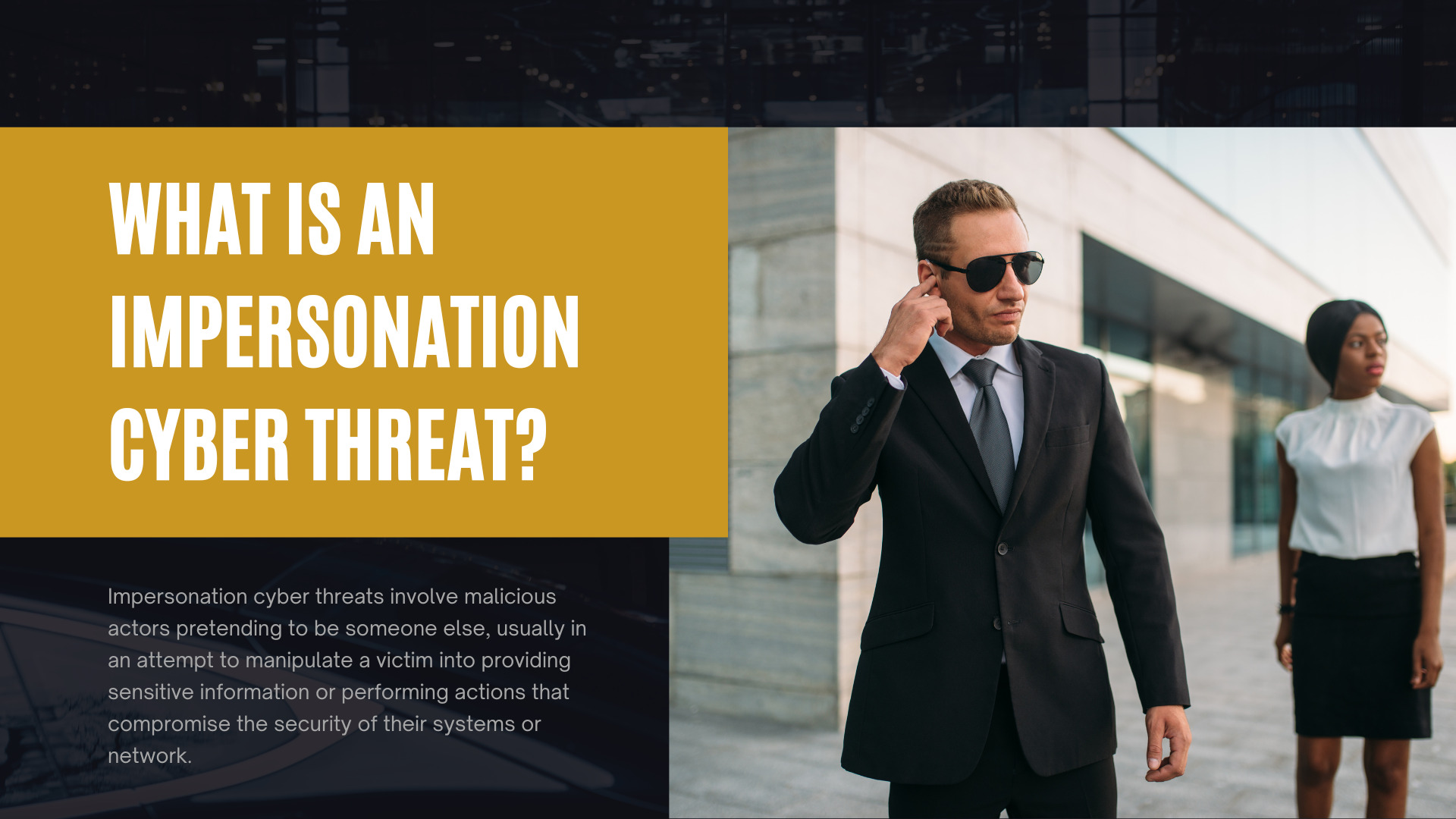Decoding Digital Deception
In the rapidly evolving world of cybersecurity, the threat landscape continues to expand as criminals devise more sophisticated techniques. One such method that has steadily risen in recent years is impersonation cyber threats. Impersonation pertains to cyberattacks. It involves a perpetrator using social engineering tactics to trick their target into believing they are someone else, often to illicitly gain access to personal information or infiltrate a protected network.
Understanding the nuances of impersonation cyber threats is integral to fortifying one’s cybersecurity defenses. These attacks come in various forms, such as phishing emails, spoofed websites, and even direct messaging on social media platforms. Cybercriminals often impersonate trusted entities, like colleagues, friends, or well-known institutions, to exploit their victims’ trust.
By remaining vigilant and developing a clear comprehension of impersonation cyber threats, individuals and organizations can better safeguard their sensitive data and maintain robust cyber hygiene. As technology advances, staying one step ahead of potential attackers and recognizing the ever-present risks in the digital landscape is crucial.

Understanding Impersonation Cyber Threats
Impersonation cyber threats involve malicious actors pretending to be someone else, usually attempting to manipulate a victim into providing sensitive information or performing actions compromising the security of their systems or network. The impersonation can often be executed through various properties of digital communication, including email, text messages, or social media.
Types of Impersonation Attacks
There are several types of impersonation attacks, some of which include:
- Phishing: A phishing attack involves sending deceptive emails to trick users into revealing sensitive information, such as passwords or credit card numbers.
- Spear-phishing: Similar to phishing, spear-phishing targets specific individuals, often using personalized information to make the message more believable.
- Whaling: This attack focuses on high-profile targets, such as CEOs or executives, who typically have access to sensitive information or financial assets.
- Business email compromise (BEC): BEC attacks involve impersonating employees or business partners to trick victims into transferring funds or providing sensitive information.
Common Techniques
Some common techniques used in impersonation cyber threats include:
- Domain spoofing: Attackers create a website or email address resembling a legitimate domain to deceive victims.
- Display name deception: The attacker modifies the display name of an email or message so it appears to come from a trusted source.
- Social engineering: By using manipulation tactics, such as posing as a trusted authority figure, attackers can gain the confidence of their victims to extract valuable information or trick them into compromising their own security.
The clarity and formatting of this information aim to make it easier for readers to understand the various aspects of impersonation cyber threats. The types of impersonation attacks and common techniques help provide a comprehensive understanding of this growing cybersecurity concern.
Impact of Impersonation Threats on Individuals and Organizations
Financial Loss
Impersonation cyber threats can lead to significant financial losses for individuals and organizations. Attackers use social engineering techniques to deceive victims into disclosing sensitive information or re-direct funds to unauthorized accounts. They often accomplish this by pretending to be someone the victim trusts, such as a colleague, company executive, or financial institution representative. In some cases, these attacks result in direct monetary loss. For example, an individual may transfer funds to a fraudulent account, or a business might pay a fake invoice.
Organizations can also experience indirect financial losses due to an impersonation attack. They may need to invest in updating their security infrastructure, implementing employee training, and hiring experts to mitigate future threats. Additionally, organizations may face legal fees and regulatory fines if they have insufficient security measures to prevent such attacks.
Reputational Damage
When impersonation attacks are successful, they can cause significant damage to an organization’s reputation. For example, customers and partners may question the company’s security and data protection commitment. In the age of social media, news of a data breach or other cyber incident can travel quickly, leading to a loss of brand trust and loyalty. This reputational damage can be difficult to quantify, but it can have long-lasting effects on an organization’s ability to attract new customers and maintain existing relationships.
For individuals, falling victim to an impersonation attack can also harm their reputation. In some cases, the attacker may impersonate the individual to engage in malicious activity, such as spreading false information, harassing other users, or engaging in online scams. As a result, the victim’s online reputation may suffer, potentially affecting their career and social standing.
Data Breach
Impersonation cyber threats can lead to data breaches if attackers gain unauthorized access to sensitive information. These breaches may involve the theft of personal data, such as Social Security numbers, credit card numbers, or passwords. The attackers can then exploit this exposed information, may sell it on the dark web, use it for targeted phishing attacks, or commit other forms of identity theft.
A data breach can have severe consequences for organizations, such as regulatory penalties and costly remediation efforts, including notifying affected customers and providing credit monitoring services. Companies must also contend with the potential loss of intellectual property, which can significantly impact their competitive standing in the marketplace.
Preventing and Mitigating Impersonation Cyber Threats
Impersonation cyber threats are becoming increasingly common. To better protect your organization, it’s important to implement comprehensive strategies. The following sub-sections outline various methods for preventing and dealing with impersonation cyber threats.
Security Controls
Implementing strong security controls is one of the most effective ways to protect against impersonation cyber threats. Key security measures to implement include:
- Multi-factor authentication (MFA): Require users to provide two or more forms of authentication, such as a password and a temporary code received by text or through an authentication app.
- Email security: Utilize tools such as Domain-based Message Authentication, Reporting, and Conformance (DMARC), Sender Policy Framework (SPF), and DomainKeys Identified Mail (DKIM) to authenticate the emails received by your organization.
- Endpoint protection: Protect devices and systems that connect to your network through antivirus software, firewalls, and intrusion detection systems.
- Access control: Implement strict access management policies and use a least-privilege model, ensuring employees only have access to the necessary data and systems.
User Awareness Training
Educating employees on how to recognize and respond to impersonation cyber threats is crucial. To increase user awareness, organizations should:
- Conduct training sessions on cyber threats, including impersonation tactics, phishing, and social engineering.
- Update training materials and sessions regularly to cover emerging threat trends.
- Encourage a culture of vigilance by incentivizing employees to report suspicious activities or attempts at impersonation.
- Test employees through simulated phishing attacks and evaluate the effectiveness of your training programs.
Incident Response Planning
Developing an incident response plan is essential for organizations to efficiently respond to impersonation cyber threats. Key elements of a successful incident response plan should include:
- Designation of an incident response team with clearly defined roles and responsibilities.
- A step-by-step process for handling incidents, including detection, analysis, containment, eradication, and recovery.
- Regular updates and review of the plan to ensure its effectiveness.
- Collaboration with external stakeholders, such as law enforcement and industry partners, to share threat intelligence and best practices.
By implementing these steps, organizations can significantly reduce their risk of falling victim to impersonation cyber threats.
Frequently Asked Questions
How do attackers gain trust?
Attackers often gain trust by impersonating someone or an organization that the target is familiar with. They may use tactics such as researching the target’s social and professional connections, sending emails that appear to be from legitimate sources, or forging websites and profiles to appear trustworthy. These tactics can lower the victim’s guard and make them more likely to share sensitive information.
What are common examples?
Common examples of impersonation cyber threats include phishing attacks, spear phishing, social engineering, malicious apps, and fraudulent websites. These attacks rely on deceiving the target into thinking they are interacting with a trusted source, often intending to obtain sensitive information or access secure systems.
How does it differ from spoofing?
Impersonation and spoofing both involve assuming a fake identity, but the key difference is the intent behind the actions. Impersonation aims to gain trust and deceive the target, while spoofing focuses on hiding or disguising the true origin of the communication. Spoofing often serves as a technique used in impersonation attacks to make the deception more convincing.
What techniques are used?
Impersonators employ a variety of techniques, including email spoofing, social engineering, website cloning, and creating fake social media profiles. These techniques mimic legitimate entities’ appearance, language, and behaviors, making it difficult for victims to discern between real and deception.
How can it be detected and prevented?
Detecting and preventing impersonation cyber threats involve a combination of technical measures, user education, and security policies. Technical solutions include implementing robust email filters, using multi-factor authentication, and monitoring for unauthorized access attempts. Educating users about common threats, being cautious with unsolicited emails, and reporting suspicious activities are also critical. Organizations can develop and enforce policies limiting the sharing of sensitive information to reputable sources.
Which industries are most targeted?
Industries that handle sensitive data or rely heavily on online communication are most targeted by impersonation attacks. These include the financial and banking sectors, healthcare, technology, and government organizations. The high value of their data makes them attractive targets for attackers.


